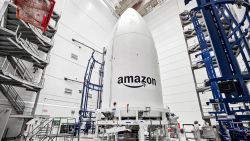The majority of SpaceX’s first 60 internet-beaming satellites have now reached their final destinations in Earth’s orbit. It’s a largely successful step forward in the company’s plans to one day deliver cheap, speedy broadband from space.
Next on SpaceX’s checklist is to actually use the satellites to access the internet and test out how well the network operates. The company said Friday that it will test “latency and capacity by streaming videos and playing some high bandwidth video games.”
SpaceX hopes its satellite internet project, called Starlink, will one day grow to include thousands of satellites and offer coverage all over the globe.
The company hopes that Starlink could one day bring internet access to a significant portion of the world’s population who live in areas without the infrastructure for wireless or WiFi service. CEO Elon Musk has also said that it could offer a competitively priced alternative for people who may be unhappy with their current service.
Many questions about the project are still unanswered: namely, whether SpaceX can spend billions to develop the Starlink constellation and still offer attractive prices to consumers, and whether Starlink’s broadband will actually be as quick and reliable as other internet services. Right now, internet is mostly delivered via wireless cell towers or cables routed to your home or office.
SpaceX said Friday that it will test the first batch of Starlink satellites using ground antennas in North America. Eventually, the company wants to put as many as 1 million ground stations in place that will connect to the satellite network, according to a document the company submitted to US regulators.
Of the 60 satellites launched in May, only three malfunctioned and were unable to communicate with the ground, a SpaceX spokesperson said Friday. Those devices will be leftto float around aimlessly until the Earth’s gravity can slowly drag them back out of orbit, which could take as long as five years.
Two other satellites will be directed to intentionally dive back toward Earth to “simulate an end of life disposal.” SpaceX wants its functioning satellites to save enough fuel for the journey home after they finish their business in space, and this pair of satellites will test out the method for doing that. Purposely taking satellites out of orbit is part of SpaceX’s plan to ensure its satellites don’t contribute to the space junk issue.



























